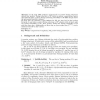Free Online Productivity Tools
i2Speak
i2Symbol
i2OCR
iTex2Img
iWeb2Print
iWeb2Shot
i2Type
iPdf2Split
iPdf2Merge
i2Bopomofo
i2Arabic
i2Style
i2Image
i2PDF
iLatex2Rtf
Sci2ools
CORR
1999
Springer
1999
Springer
On the Power of Positive Turing Reductions
: In the early 1980s, Selman's seminal work on positive Turing reductions showed that positive Turing reduction to NP yields no greater computational power than NP itself. Thus, positive Turing and Turing reducibility to NP di er sharply unless the polynomial hierarchy collapses. We show that the situation is quite di erent for DP, the next level of the boolean hierarchy. In particular, positive Turing reduction to DP already yields all and only sets Turing reducibility to NP. Thus, positive Turing and Turing reducibility to DP yield the same class. Additionally, we show that an even weaker class, PNP 1 , can be substituted for DP in this context. Category: F.1 Key Words: computational complexity, NP, positive Turing reductions 1 Background and De nitions A quarter century ago, Selman initiated the study of polynomial-time positive Turing reductions. A truth-table version of this reducibility had been introduced a few years earlier, by Ladner, Lynch, and Selman LLS75 . Polynomial-...
| Added | 22 Dec 2010 |
| Updated | 22 Dec 2010 |
| Type | Journal |
| Year | 1999 |
| Where | CORR |
| Authors | Edith Hemaspaandra |
Comments (0)

